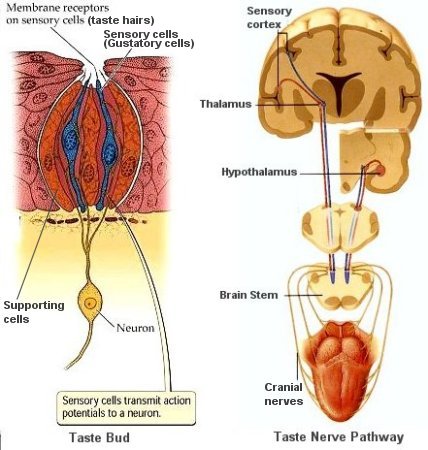|
|
alternatives treatment of autoimmune
disease read our
e-book
Special Google
Health Search
Contents
Neurons and Nerves
Neurotransmitter
The Brain
Spinal Cord
Peripheral
Nervous System
Autonomic
Nervous System
Senses:
Sight,
Senses,
Smell,
Taste,
Sences,
Senses
Memory
Higher Functions
Altered States
 |
Taste buds - The tasting, or gustatory, cells in the
buds have hairy tips which detect chemicals in solution
(secreted by the gland at the bottom of papilla). When
stimulated by flavor molecules, these cells generate nerve
signals, which they send to the taste center on the brain's
cortex, and also to the hypothalamus, which is concerned
with appetite and the salivating reflex.
Taste nerve pathway - The nerve signals are carried by
three nerves in each side of the tongue (cranial nerves) to
a small part of the medulla (brain stem). The signals then
travel to parts of the brain, such as the hypothalamus, the
thalamus, and the gustatory part of the sensory cortex - the
"taste center", where the signals are interpreted (Figure
21). The thalamus acts like a relay station, shunting the
data onto appropriate cortical areas for processing. The
sense of taste tells us what is good to eat. It evolved to
pick out sweet, ripe fruits and energy-packed sugars
|
|
|
and starches. Likewise,
taste is is extremely sensitive to bitter flavors, because
many poisonous berries, fruits and fungi are bitter-tasting.
|
Sensations (see location of the
various components in
Figure 09):
- Skin - Skin has a thin epidermis, which is mainly for protection, and
a thicker dermis below. In addition to small blood vessels and
sweat glands, it has tiny nerve endings in the various type of
touch receptors (see
Figure 09).
- Receptors -
- Bulb of Krause - These are multi-layered capsules with
many branched nerve endings. They are quick-change
mechanoreceptors, triggered by rapid alterations in shap
caused by pressure or vibrations, and may also help us to
feel extreme cold.
-
- Free nerve endings - They have a treelike branching
system of naked nerve fibers. They are the most common
sensory endings in the skin and detect just about anything -
light touch, heavy pressure, heat, cold, and importantly,
pain. Slight stimulation of these nerve endings may elicit
the sensation that is known as itching.
- Meissner's endings - They are found in the uppermost
part of the dermis, especially on the hands, feet, lips, and
inner surfaces of the eyelids. They are shaped like eggs and
are both quick- and slow-change mechanoreceptors, detecting
light touch and vibrations.
Continue to
Proprioceptors
|
|
|
|
|
|
|